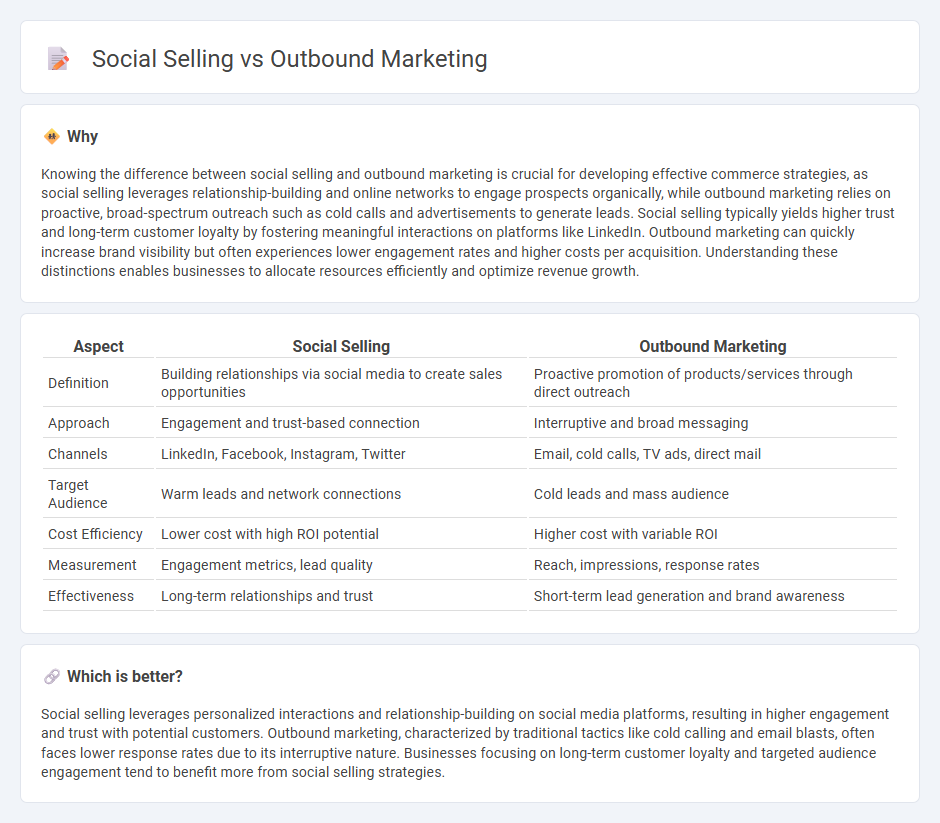
Social selling leverages social media platforms to build relationships and engage potential customers through personalized interactions, enhancing trust and long-term loyalty. Outbound marketing focuses on proactive outreach through channels like cold calls, email blasts, and advertisements to capture immediate leads and increase brand visibility. Discover how integrating these strategies can maximize your commerce success.
Why it is important
Knowing the difference between social selling and outbound marketing is crucial for developing effective commerce strategies, as social selling leverages relationship-building and online networks to engage prospects organically, while outbound marketing relies on proactive, broad-spectrum outreach such as cold calls and advertisements to generate leads. Social selling typically yields higher trust and long-term customer loyalty by fostering meaningful interactions on platforms like LinkedIn. Outbound marketing can quickly increase brand visibility but often experiences lower engagement rates and higher costs per acquisition. Understanding these distinctions enables businesses to allocate resources efficiently and optimize revenue growth.
Comparison Table
| Aspect | Social Selling | Outbound Marketing |
|---|---|---|
| Definition | Building relationships via social media to create sales opportunities | Proactive promotion of products/services through direct outreach |
| Approach | Engagement and trust-based connection | Interruptive and broad messaging |
| Channels | LinkedIn, Facebook, Instagram, Twitter | Email, cold calls, TV ads, direct mail |
| Target Audience | Warm leads and network connections | Cold leads and mass audience |
| Cost Efficiency | Lower cost with high ROI potential | Higher cost with variable ROI |
| Measurement | Engagement metrics, lead quality | Reach, impressions, response rates |
| Effectiveness | Long-term relationships and trust | Short-term lead generation and brand awareness |
Which is better?
Social selling leverages personalized interactions and relationship-building on social media platforms, resulting in higher engagement and trust with potential customers. Outbound marketing, characterized by traditional tactics like cold calling and email blasts, often faces lower response rates due to its interruptive nature. Businesses focusing on long-term customer loyalty and targeted audience engagement tend to benefit more from social selling strategies.
Connection
Social selling leverages personalized interactions on social media platforms to build relationships and trust with potential customers, directly complementing outbound marketing strategies that proactively reach out through channels like email, cold calls, and advertisements. Both approaches aim to engage target audiences, with social selling enhancing outbound marketing efforts by providing rich customer insights and fostering genuine connections that improve lead conversion rates. Integrating these methods boosts brand visibility and drives revenue growth by combining the proactive reach of outbound marketing with the relational power of social selling.
Key Terms
Lead Generation
Outbound marketing uses targeted advertisements, cold calls, and email campaigns to generate leads rapidly by pushing promotional messages to a wide audience. Social selling leverages social media platforms to build relationships, engage potential customers, and nurture leads through personalized interactions and content sharing. Explore deeper insights on how each method can optimize your lead generation strategy effectively.
Customer Engagement
Outbound marketing relies on broad-reaching strategies such as cold calls, email blasts, and advertisements to capture consumer attention, often resulting in less personalized interactions. Social selling leverages social media platforms to build genuine relationships and trust by engaging prospects through relevant content, meaningful conversations, and timely responses. Explore how integrating social selling techniques can enhance customer engagement and drive sustainable business growth.
Conversion Rate
Outbound marketing typically relies on broad outreach techniques like cold calls and email blasts, yielding an average conversion rate of around 1-3%. Social selling leverages personalized interactions on platforms like LinkedIn and Twitter, achieving higher conversion rates often exceeding 7-13% due to trust-building and targeted engagement. Explore the advantages of each strategy to optimize your marketing efforts for better conversion outcomes.
Source and External Links
Outbound Marketing Examples To Grow Brand Awareness & Pipeline - Outbound marketing is a method of reaching potential customers before interest is established, using tactics like cold emails, TV ads, and billboards, focusing on relevance and thoughtful engagement rather than mass annoyance.
What Is Outbound Marketing? - WordStream - Outbound marketing is any marketing where a company initiates contact with the audience through traditional channels like TV commercials, cold calls, print ads, and email spam, contrasting inbound methods where customers seek out the brand.
Inbound Vs Outbound Marketing: What is the Difference? - Outbrain - Outbound marketing, while traditional and often harder to track, remains effective for local targeting, building brand awareness, and reaching older audiences comfortable with radio, TV, and print ads, making it a key element of omnichannel marketing.
 dowidth.com
dowidth.com